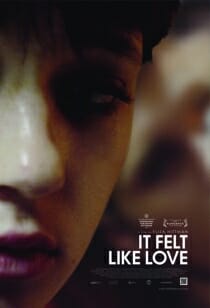
With It Felt Like Love, writer-director Eliza Hittman takes a few routine subjects—the coming-of-age story, sexual awakening, adolescent confusion—and reminds us that a confident directorial voice can make material this common appear as fresh, strange, and surprising as a good science-fiction story. Hittman has made some well-received short films (2010’s Second Cousins Once Removed, 2011’s Forever Gonna Start Tonight), but this is her debut feature, and her command over everything—performance, style, tone, imagery—announces her as a noteworthy new filmmaker. She herself invokes Maurice Pialat and Catherine Breillat when describing her influences in this genre, but her fascination with skin and bodies also owes a debt to Claire Denis. But these inspirations neither overwhelm the material nor lessen Hittman’s achievement—if anything, they highlight the fact that the American-indie scene is in desperate need of more female directors who can approach this thematic territory with such formal and psychological curiosity.
The movie’s opening image shows the protagonist, 14-year-old Lila (Gina Piersanti), standing on the shore of a beach, staring out onto the water in a one-piece bathing suit. At the start of the shot, she’s out-of-focus; by the end of it, her back has come sharply into focus. (Hittman’s use of shallow focus is one of the movie’s greatest qualities; one particularly enthralling example arrives during a fleeting moment aboard a Ferris wheel, when Lila’s blurry hand collides with the people below on the ground.) Our first look at Lila’s face, which directly precedes the title card, is startling: it’s caked with white sunscreen lotion, and she’s staring back into the camera, as if wondering what we’re even doing here watching her. The bulk of the movie doesn’t break the diegesis in this manner, which retroactively makes the opening feel heavy-handed. (Though it offers a spellbinding match cut, the film’s Eyes Without a Face-esque concluding bookend nevertheless suffers from a similar fault.) But as a series of frames intended to get us interested in a character, this 60-second sequence functions nicely.
Set during a hot summer in a working-class Brooklyn neighborhood, It Felt Like Love’s primary concern is charting Lila’s sexual anxieties and experiences. She dotes on her more naturally flirtatious best friend, Chiara (Giovanna Salimeni), who makes no qualms about necking with her new boyfriend, Patrick (Jesse Cordasco), in Lila’s presence. For her part, it’s not like Lila exactly objects to this—indeed, she takes an avid interest in observing Chiara from a distance, noting her behavior, and even, in one instance, repeating verbatim one of Chiara’s intimate sexual observations to a younger boy (Case Prime). However, not content to merely enjoy sex vicariously, Lila soon sets her sights on the tattooed, college-aged Sammy (Ronen Rubinstein), who grows simultaneously intrigued and confused by the sudden presence of Lila in his life.
The scenes between Lila, Sammy, and Sammy’s macho friends feature some of Hittman’s most acute dialogue and direction. In the first, the bros pass around a gigantic blunt while watching porn together—a weird activity made all the more uncomfortable by Lila’s impulsively articulated aspirations of becoming an adult-film star. (Lila’s reasoning—“Like, the hours are really good, and so is the pay”—is hilarious and sharp, as is the abrupt notice taken by one of the guys, who perks up and asks her, “What’s your name again?”) Later, when Lila again finds herself in the company of these dudes, Hittman employs one of her most striking strategies, mixing sex-related content (Lila offering to perform oral sex) with mundane background detail (ESPN-style sports commentary on the off-screen television). This is an echo of an earlier scene between Chiara and Patrick, in which their lovemaking and relationship-testing conversation is cut down by the noise of passing-by traffic.
This is one of the reasons why describing It Felt Like Love as “naturalistic,” while perhaps accurate and useful in some sense, is still a little limiting. Hittman’s aforementioned experimentation with soft focus is nothing less than extreme, and her employment of slow motion and expressive colors likewise pushes the material into aesthetically adventurous terrain. A key party sequence in the middle of the film speaks to this: Hittman depicts Lila wandering through the space in a slow-motion haze, surrounded by red and green. Elsewhere, Hittman rejects typical, movie-friendly establishing shots of the Brooklyn setting, an admirable subjective move that resembles another recent Brooklyn-set indie: Andrew Dosunmu’s Mother of George.
Hittman and cinematographer Sean Porter’s insistence on close-ups puts a lot of weight on the shoulders of Piersanti—who, like her director, is here giving her feature debut. But the actress responds to the challenge with an absorbing performance that manages to remain true to the film’s troubling ambiguity without sacrificing psychological consistency or clarity. Lila’s angsts and impulses may be beyond our full comprehension, but Piersanti always provides us with enough information to go on. And Hittman, though it would’ve been easy, never allows Piersanti or the other performers to carry her film. The director is constantly leaving her actors’ faces out-of-frame in order to prioritize other parts of the body: shoulder blades, thighs, legs, forearms, hands, feet, the neck, the spreading of lotion on the lower back. The movie emphasizes such textures because these characters (Lila, in particular) are far too young to think about love—all they can do is approximate it through their bodies.
Director: Eliza Hittman
Writer: Eliza Hittman
Starring: Jesse Cordasco, Gina Piersanti, Ronen Rubinstein, Giovanna Salimeni
Release Date: Mar. 21, 2014